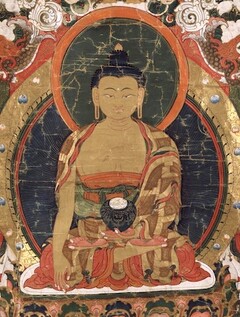Śākyamuni Guru Yoga
༄༅། །བླ་མ་ཐུབ་པ་ཆེན་པོའི་བླ་མའི་རྣལ་འབྱོར་བཞུགས་སོ། །
Guru Yoga of the Guru Mahāmuni
by Jamyang Khyentse Chökyi Lodrö
ན་མོ་ཤཱཀྱ་མུ་ནི་ཡེ།
Namo śākyamunaye!1
ཐུབ་པ་ཆེན་པོ་དང་བླ་མ་དབྱེར་མེད་དུ་སྒྲུབ་པའི་ཐབས་ཉམས་སུ་བླང་བར་འདོད་པས། སྐྱབས་སེམས་སྔོན་དུ་བཏང་ལ་ཚད་མེད་པ་བཞི་ཡང་ནས་ཡང་དུ་བསྒོམ་ཞིང་།
Those who wish to practise a means of accomplishing the Great Sage, indivisible from the guru, should begin by taking refuge and generating bodhichitta as well as by meditating repeatedly on the four immeasurables. Then:
མ་དག་སྣོད་བཅུད་མི་དམིགས་སྟོང་པར་སྦྱངས། །
ma dak nöchü mimik tongpar jang
The impure environment and inhabitants are purified into non-referential emptiness.
སྟོང་པའི་ངང་ལས་ཞིང་ཁམས་ཕུན་སུམ་ཚོགས། །
tongpé ngang lé zhingkham pünsum tsok
Out of the state of emptiness appears a perfect realm,
ཡངས་ཤིང་རྒྱ་ཆེ་བཀོད་པ་ཕུན་ཚོགས་དབུས། །
yang shing gyaché köpa püntsok ü
Vast, expansive and magnificently arranged.
བྷྲཱུྃ་ལས་རིན་ཆེན་ལས་གྲུབ་གཞལ་མེད་ཁང་། །
droom lé rinchen lé drub zhalmé khang
In its centre, from a syllable bhrūṃ arises a jewelled palace,
དེ་དབུས་སེང་ཁྲི་པདྨ་ཟླ་བའི་སྟེང་། །
dé ü sengtri pema dawé teng
In the middle of which, upon a lion throne, lotus and moon,
མུ་ཡིག་གསེར་གྱི་མདོག་ཅན་ཡོངས་གྱུར་ལས། །
mu yik ser gyi dokchen yong gyur lé
Is a syllable mu, golden in colour, which transforms
བླ་མ་བཅོམ་ལྡན་ཤཱཀྱ་ཐུབ་པ་ཆེ། །
lama chomden shakya tubpa ché
Into the Guru as the great blessed one Śākyamuni.
གསེར་མདོག་མཚན་དཔེའི་གཟི་བརྗིད་དཔལ་དུ་འབར། །
ser dok tsenpé ziji pal du bar
He is the colour of gold and blazes with the splendour of the signs and marks.
ཕྱག་གཡས་ས་གནོན་གཡོན་པས་མཉམ་བཞག་མཛད། །
chak yé sa nön yönpé nyamzhak dzé
His right hand touches the earth while his left rests in equanimity.
སྐུ་ལ་ཆོས་གོས་རྣམ་གསུམ་མཛེས་པར་བཀླུབས། །
ku la chögö nam sum dzepar lub
He is elegantly garbed in the three dharma robes.
ཞབས་གཉིས་རྡོ་རྗེའི་སྐྱིལ་ཀྲུང་གཡོ་མེད་བཞུགས། །
zhab nyi dorjé kyiltrung yomé zhuk
His two legs are crossed in the immovable vajra posture.
གནས་གསུམ་ཡིག་འབྲུ་གསུམ་གྱིས་མཚན་པ་ལས། །
né sum yikdru sum gyi tsenpa lé
From the three syllables that mark his three centres,
ཡེ་ཤེས་སྤྱན་དྲངས་དམ་ཡེ་དབྱེར་མེད་གྱུར། །
yeshe chendrang damyé yermé gyur
Light invokes the wisdom deity, who dissolves inseparably into the samayasattva.
བཟང་པོ་སྤྱོད་པ་ནས་འབྱུང་བའི་ཡན་ལག་བདུན་པ་དང་། སྤྲོ་ན་མཎྜལ་ཀྱང་ཕུལ། དེ་ནས་དད་མོས་རྩེ་གཅིག་པས།
Perform the seven branches from the Aspiration to Good Actions.2 If you wish, you could also offer a maṇḍala. Then, with single-pointed faith and devotion, recite:
བླ་མ་སྟོན་པ་བཅོམ་ལྡན་འདས་དེ་བཞིན་གཤེགས་པ་དགྲ་བཅོམ་པ་ཡང་དག་པར་རྫོགས་པའི་སངས་རྒྱས་དཔལ་རྒྱལ་བ་ཤཱཀྱ་ཐུབ་པ་ལ་ཕྱག་འཚལ་ལོ།
lama tönpa chomdendé dezhin shekpa drachompa yangdakpar dzokpé sangye pal gyalwa shakya tubpa la chaktsal lo
Supreme teacher, bhagavān, tathāgata, arhat, complete and perfect buddha, glorious conqueror, Śākyamuni, to you I bow. To you I pay homage.
མཆོད་དོ་སྐྱབས་སུ་མཆིའོ།
chö do kyab su chi o
In you I take refuge.
བྱིན་གྱིས་བརླབ་ཏུ་གསོལ། །
jingyi lab tu sol
Grant your blessings, I pray.
ལན་གྲངས་ཅི་ནུས་བརྗོད། ཐུགས་དམ་རྒྱུད་བསྐུལ་གྱི་བཟླས་པ་བྱ་བ་ནི། །
Recite this as many times as you can. Then, as the recitation for invoking the wisdom mind, recite:
ཨོཾ་ན་མོ་བྷ་ག་ཝ་ཏེ་ཤཱཀྱ་མུ་ནེ་ཡེ། ཏ་ཐཱ་ག་ཏཱ་ཡ། ཨརྷ་ཏེ་སམྱཀྶཾ་བུདྡྷ་ཡེ། ཏདྱ་ཐཱ། ཨོཾ་མུ་ནི་མུ་ནི་མ་ཧཱ་མུ་ནི་ཤཱཀྱ་མུ་ནེ་ཡེ་སྭཱ་ཧཱ།
om namo bhagawaté shakya muneyé tata gataya arahaté samyaksambuddha yé | teyata om muni muni mahamuni shakyamuneyé soha
Oṃ namo bhagavate śākyamunaye | tathāgatāya | arhate saṃyaksaṃbuddhaye | tadyathā | oṃ muni muni mahāmuni śākyamuniye svāhā |
ཅི་འགྲུབ་བཟླ།
Recite this as many times as possible.
སྟོན་པའི་ཐུགས་ཀ་དང་སྨིན་མཚམས་ཀྱི་མཛོད་སྤུ་ལ་སེམས་རྩེ་གཅིག་ཏུ་རྟོག་པ་མི་འཕྲོ་བར་གཏད། སྐབས་སུ་སྨིན་མཚམས་ཀྱི་མཛོད་སྤུ་དང་། ཞལ་གྱི་སྒོ་དང་། ཐུགས་ཀ་ནས་འོད་ཟེར་བསམ་གྱིས་མི་ཁྱབ་པ་འཕྲོས། འཇིག་རྟེན་གྱི་ཁམས་ཐམས་ཅད་སྦྱངས། ངན་སོང་གི་གནས་རྣམས་སྟོང་པར་བྱས། སེམས་ཅན་ཐམས་ཅད་བླ་ན་མེད་པའི་བྱང་ཆུབ་ལ་འགོད་པར་མོས་ལ་སྙིང་རྗེ་ཆེན་པོ་ལ་བློ་སྦྱངས། བདག་དང་སེམས་ཅན་ཐམས་ཅད་རང་བཞིན་གྱིས་གྲུབ་པ་མེད་ཅིང་། སྐྱེ་མེད་སྤྲོས་བྲལ་ལ་བློ་གཏད་དེ་བདག་མེད་རྟོགས་པའི་ཤེས་རབ་ལྷག་མཐོང་གི་གནས་ལུགས་ལ་མཉམ་པར་བཞག །
Focus your attention single-pointedly on the Teacher's heart and the circle of hair between his eyebrows, without allowing thoughts to proliferate. Periodically, consider that unimaginable rays of light pour from his circle of hair, mouth and heart; they purify all the realms of this world, empty the domains of the lower realms, and bring all beings to unsurpassable awakening. As you imagine this, train your mind in great compassion. Then, consider how you and all other beings lack true reality. Direct your mind towards the unarisen state that is free from elaboration and settle in the natural state of vipaśyanā, the wisdom that realizes selflessness.
ཐུན་མཐར།
At the end of the session recite:
ཐུབ་དབང་བླ་མའི་གནས་གསུམ་འབྲུ་གསུམ་ལས། །
tubwang lamé né sum dru sum lé
Rays of light stream out from the three syllables at the three centres
འོད་ཟེར་བྱུང་བ་བདག་གི་གནས་གསུམ་ཐིམ། །
özer jungwa dak gi né sum tim
Of the Guru, Lord of Sages, and dissolve into my own three centres.
ལུས་ངག་ཡིད་ཀྱི་སྒྲིབ་པ་རབ་དག་ནས། །
lü ngak yi kyi dribpa rab dak né
They purify entirely all my physical, vocal and mental obscurations,
སྐུ་གསུང་ཐུགས་ཀྱི་དངོས་གྲུབ་ཐོབ་པར་གྱུར། །
ku sung tuk kyi ngödrub tobpar gyur
And grant the attainments of enlightened body, speech and mind.
ཨོཾ་ཨཱཿཧཱུྃ།
om ah hung
oṃ āḥ hūṃ
ཅི་ནུས་བཟླ།
Recite the mantra as many times as possible.
མཐར་ནི་བླ་མ་འོད་དུ་ཞུ། །
tar ni lama ö du zhu
Finally the guru melts into light.
འོད་ཀྱི་གོང་བུ་གསེར་གྱི་མདོག །
ö kyi gongbu ser gyi dok
And, as a luminous orb, gold in colour,
རང་གི་སྙིང་གར་ཐིམ་པ་དང་། །
rang gi nyingkar timpa dang
Dissolves into my own heart.
ཐུགས་ཡིད་བསྲེ་བའི་ངང་ལ་བཞག །
tuk yi sewé ngang la zhak
And in the merging of mind and wisdom, I rest.
ཐུན་ལས་ལྡང་བ་ན་བསྔོ་བ་སྨོན་ལམ་རྒྱས་བསྡུས་ཅི་རིགས་བྱ་ཞིང་། །ཐུན་མཚམས་སུའང་རྗེས་དྲན་དྲུག་དང་ཆོས་སྤྱོད་བཅུ་ལ་བརྩོན་པར་བྱའོ། །
When rising from the session, recite verses of dedication and aspiration of appropriate length. In between sessions, exert yourself in the six recollections3 and ten forms of dharmic activity.4
ཞེས་པའང་མེ་སྤྲེལ་སྨིན་ཟླའི་དཀར་ཕྱོགས་ཀྱི་རྒྱལ་བ་གསུམ་པར་འཇམ་དབྱངས་ཆོས་ཀྱི་བློ་གྲོས་པས་མ་གྷ་དྷའི་གནྡྷོ་ལ་ཆེན་པོའི་ཉེ་ལོགས་སུ་བྲིས་པ་དོན་དང་ལྡན་པར་བྱིན་གྱིས་བརླབ་ཏུ་གསོལ། སརྦ་མངྒ་ལཾ།། །།
Thus, on the third 'victorious' day of the waxing phase5 of the Kārttika (tenth) month in the Fire Monkey year, Jamyang Chökyi Lodrö wrote this in the vicinity of the great gandhola of Magadha. I pray that it be blessed with purpose. Sarva maṅgalam.
| Translated by Adam Pearcey with the generous support of the Khyentse Foundation and Tertön Sogyal Trust, 2020.
Source:
'Jam dbyangs chos kyi blo gros. "bla ma thub pa chen po'i bla ma'i rnal 'byor/" in ’Jam dbyangs chos kyi blo gros kyi gsung ’bum. 12 vols. Bir: Khyentse Labrang, 2012. W1KG12986 Vol. 4: 9–10
Version: 1.3-20230519
- ↑ This Sanskrit phrase means “Homage to Śākyamuni!” Note that although the Tibetan original says *śākyamuniye, the correct form of the dative in Sanskrit, as adopted here, is śākyamunaye.
- ↑ https://www.lotsawahouse.org/words-of-the-buddha/seven-branch-zangcho-monlam
- ↑ Recollection of the Buddha, the Dharma, the Saṅgha, generosity, discipline (or relinquishing) and the gods (or deities).
- ↑ The ten dharmic activities (chos spyod bcu) are listed in Maitreyanātha's Madhyāntavibhāga (ch. 5) as: copying texts, making offerings, giving charity, studying, reading, memorizing, explaining, reciting aloud, contemplating and meditating.
- ↑ i.e., the thirteenth day
